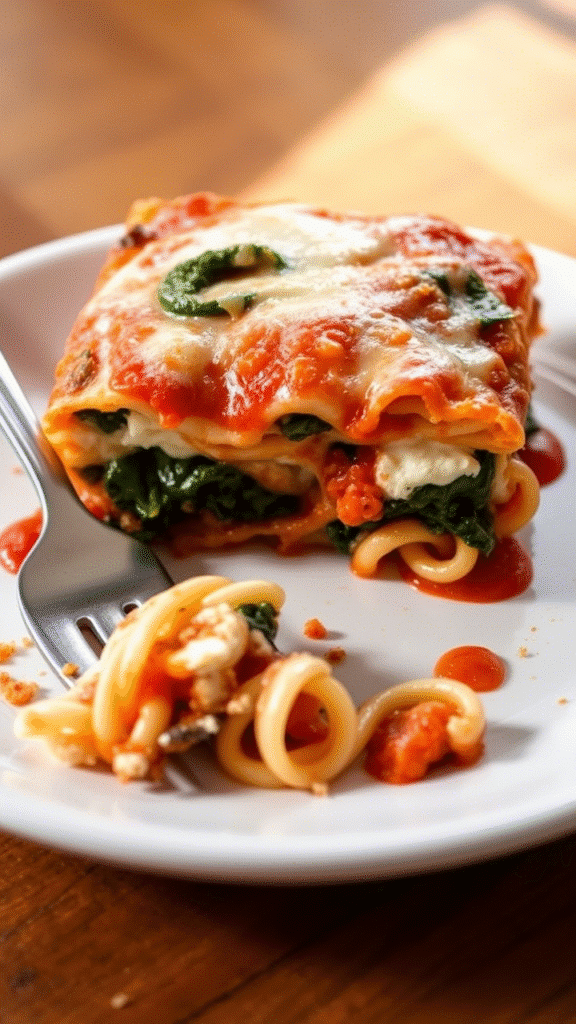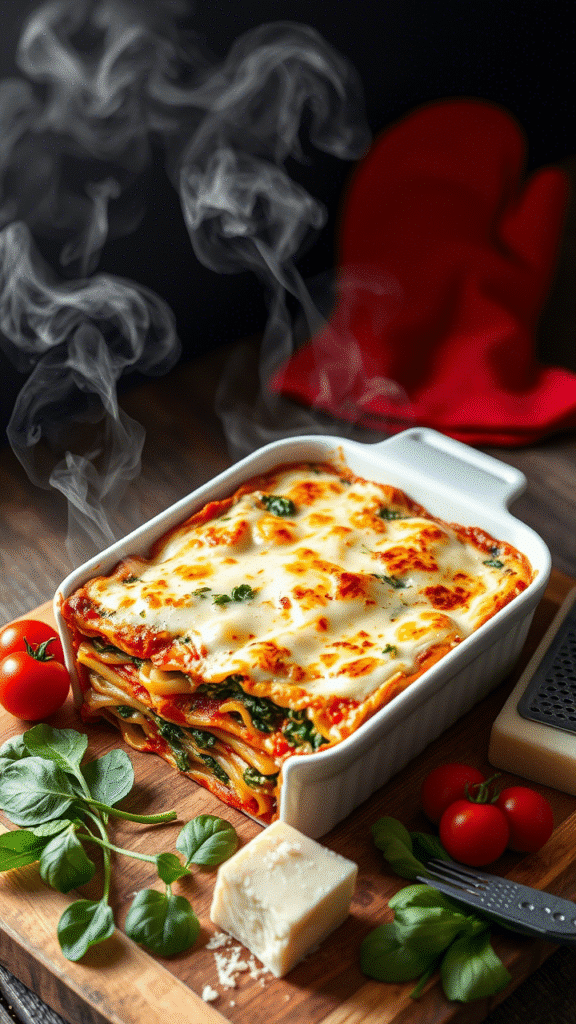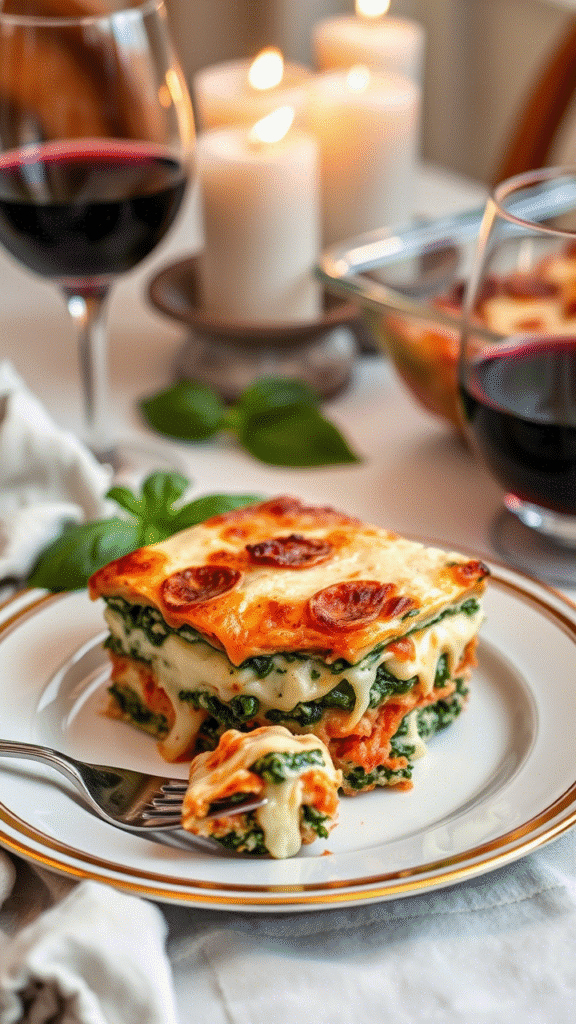The first time I made spinach lasagna, I was working the dinner shift at a small Italian bistro in North Beach. The head chef—a temperamental Sicilian who’d been making pasta since before I was born—watched me struggle with soggy noodles and watery spinach. “You cook like American,” he muttered, shaking his head. That stung, but it also taught me everything I needed to know about respecting the ingredients.
Twenty-three years later, I can tell you that spinach lasagna isn’t just comfort food. It’s a masterclass in layering flavors, managing moisture, and understanding how vegetables behave under heat. This isn’t your college dorm room assembly job—this is technique disguised as simplicity.
What makes this particular spinach lasagna special? It’s the careful balance between the earthy minerality of spinach, the creamy richness of ricotta, and that crucial step most home cooks skip: properly preparing your vegetables to prevent the dreaded soggy bottom syndrome.
Ingredients & Substitutions
The Foundation
- 12 lasagna noodles (preferably bronze-die extruded)
- 2 pounds fresh spinach (or 20 oz frozen, thawed and drained)
- 32 oz whole milk ricotta cheese
- 8 oz fresh mozzarella, torn into chunks
- 1 cup freshly grated Parmigiano-Reggiano
- 3 large eggs, room temperature
The Flavor Builders
- 4 cloves garlic, minced (not pressed—pressed garlic burns easier)
- 1 medium yellow onion, finely diced
- 3 tablespoons extra virgin olive oil
- 2 cups whole milk
- 3 tablespoons all-purpose flour
- 1/4 teaspoon freshly grated nutmeg
- 1 teaspoon kosher salt
- 1/2 teaspoon freshly cracked black pepper
- 2 tablespoons fresh basil, chiffonade
- 1 tablespoon fresh oregano (or 1 teaspoon dried)
Smart Substitutions That Actually Work
Here’s where most cookbook authors give you generic swaps that don’t understand flavor chemistry. If you can’t find fresh spinach, frozen works—but you absolutely must squeeze every drop of water out using a clean kitchen towel. I’m talking about wringing it like you’re angry at it.
For ricotta, whole milk is non-negotiable unless you’re making a diet version. Part-skim ricotta has stabilizers that change the texture. If you’re feeling ambitious, make your own ricotta—it takes twenty minutes and tastes like a completely different ingredient.
Can’t get bronze-die pasta? Regular lasagna noodles work, but bronze-die has a rougher surface that grabs sauce better. It’s the difference between good and restaurant-quality.
Fresh mozzarella versus low-moisture? Fresh mozzarella has more water content, which means more flavor but also more liquid management. Low-moisture melts more predictably but tastes like rubber comparatively. Your choice depends on whether you want to babysit your lasagna or play it safe.
Step-by-Step Instructions

Prep Work: The Foundation of Success
Start by getting your mise en place together—this French term literally means “everything in its place,” and it’s the difference between cooking and chaos. Preheat your oven to 375°F. Not 350°F like most recipes suggest. We need that extra heat to drive off moisture.
Bring a large pot of salted water to boil. The water should taste like mild seawater—about 1 tablespoon of salt per quart. Cook your lasagna noodles until they’re just shy of al dente, maybe 30 seconds less than the package suggests. They’ll finish cooking in the oven, and overcooked noodles turn to mush.
Conquering the Spinach Challenge
Here’s where most home cooks mess up. Fresh spinach contains about 90% water. That water has to go somewhere, and if you don’t manage it, it’ll turn your beautiful lasagna into spinach soup.

Heat one tablespoon of olive oil in your largest skillet over medium-high heat. Add the spinach in batches—don’t crowd the pan. Fresh spinach wilts down to almost nothing, so be patient. Season each batch lightly with salt to help draw out moisture.
Once all the spinach is wilted, transfer it to a colander and let it cool completely. Then—and this is crucial—squeeze it in small handfuls to remove as much liquid as possible. You should get about a cup of liquid out of two pounds of spinach. Save this liquid; it makes an excellent addition to vegetable stock.
Building the Béchamel
Most American lasagna recipes skip béchamel, but that’s a mistake. Béchamel isn’t just fancy—it’s functional. It binds everything together and prevents the ricotta from breaking under heat.
In a heavy-bottomed saucepan, heat the remaining olive oil over medium heat. Add the diced onion and cook until translucent, about 4 minutes. Don’t let it brown—we want sweetness, not caramelization. Add the garlic and cook until fragrant, maybe 30 seconds.
Sprinkle the flour over the vegetables and whisk constantly for about 2 minutes. This cooks out the raw flour taste and creates a roux. Slowly add the milk, whisking continuously to prevent lumps. The key here is patience—add the milk in three additions, whisking smooth between each.
Bring the sauce to a gentle simmer and cook until it coats the back of a spoon, about 8-10 minutes. Season with salt, pepper, and nutmeg. The nutmeg is traditional in béchamel and adds a subtle warmth that complements the spinach beautifully.
Assembly: Where Technique Meets Art
In a large bowl, combine the ricotta, eggs, half the Parmigiano-Reggiano, and the prepared spinach. Mix gently—overmixing makes the ricotta grainy. Season with salt and pepper, but taste first. The cheese is already salty.
Spread a thin layer of béchamel on the bottom of a 13×9 inch baking dish. This prevents sticking and adds flavor to the bottom layer. Lay down three noodles, slightly overlapping. They’ll expand as they cook.
Spread half the ricotta mixture over the noodles, then add one-third of the remaining béchamel. Scatter about one-third of the mozzarella chunks over the sauce. The chunks create pockets of molten cheese instead of a uniform layer.
Repeat the layering process: noodles, remaining ricotta mixture, half the remaining béchamel, half the remaining mozzarella. Top with the final layer of noodles, remaining béchamel, remaining mozzarella, and the rest of the Parmigiano-Reggiano.
Cooking Techniques & Science

The Moisture Management Game
Lasagna is essentially a moisture management problem disguised as comfort food. Every ingredient releases water as it heats—the noodles absorb some, but they can only hold so much. The vegetables release their cellular water, and dairy products can break and weep if heated too aggressively.
This is why we properly prepare the spinach, why we use béchamel as a binding agent, and why we cook at 375°F instead of a lower temperature. Higher heat initially helps evaporate surface moisture, creating that golden top we’re after.
Cover the lasagna with foil for the first 30 minutes. This creates a steam environment that cooks the top noodles without drying out the surface. Remove the foil and bake for another 15-20 minutes until the top is golden and bubbling around the edges.
The Science of Cheese Behavior
Ricotta is a fresh cheese with high moisture content and delicate proteins. When heated, these proteins can tighten and squeeze out moisture—that’s why we add eggs. The eggs act as a binding agent and help stabilize the ricotta’s texture under heat.
Mozzarella melts differently depending on its moisture content. Fresh mozzarella has more water, which creates steam as it heats. This steam creates those beautiful stretchy strings when you cut into the lasagna, but it also adds moisture to the dish.
Parmigiano-Reggiano is aged and has lower moisture content. It adds nutty, complex flavor and helps create that golden-brown top. The aged proteins also help bind the other ingredients together.
Tool Talk: Why Your Equipment Matters
A heavy-bottomed saucepan is essential for béchamel. Thin pans create hot spots that can scorch your sauce. A whisk with thin wires incorporates air better than a spoon and prevents lumps.
For the baking dish, ceramic or enameled cast iron holds heat better than glass. The steady, even heat helps everything cook uniformly. Glass works, but it doesn’t retain heat as well after you remove it from the oven.
A sharp knife is crucial for cutting clean slices. Lasagna is soft and layered—a dull knife will drag and make messy portions. Let the lasagna rest for at least 15 minutes before cutting. This allows the layers to set and makes serving much easier.
Serving & Pairing Suggestions

Presentation That Honors the Work
Lasagna is rustic food, but that doesn’t mean it can’t be elegant. Cut clean squares using a sharp knife wiped clean between cuts. A thin metal spatula helps lift portions without breaking the layers.
Garnish simply: a drizzle of good olive oil, fresh basil leaves, or a light sprinkle of freshly grated Parmigiano-Reggiano. The dish has enough complexity without competing garnishes.
Wine and Side Pairings
The earthiness of spinach and richness of cheese call for wines with good acidity. A Chianti Classico cuts through the richness beautifully. For white wine lovers, a crisp Pinot Grigio or Vermentino works well.
Keep sides simple. A bitter greens salad with lemon vinaigrette provides textural contrast and helps cleanse the palate. Roasted Brussels sprouts or broccoli rabe add complementary bitterness that balances the rich lasagna.
Avoid heavy sides—the lasagna is already substantial. A light soup course beforehand works better than competing starches.
Conclusion
This spinach lasagna represents everything I love about Italian-American cooking—it takes simple ingredients and transforms them through technique into something memorable. The key lessons here apply to so much more than just this dish: respect your ingredients, manage moisture carefully, and understand how heat affects different components.
The real secret isn’t in exotic ingredients or complicated techniques. It’s in the small details: properly preparing your spinach, making a proper béchamel, using quality cheese, and understanding how everything works together.
Don’t rush the process. Good lasagna takes time—not because it’s difficult, but because each step builds on the previous one. Master this version, and you’ll understand the fundamentals that apply to countless other layered dishes.
Your lasagna should rest, your cheese should melt evenly, and your first bite should have distinct layers that harmonize rather than compete. That’s the difference between following a recipe and understanding cooking.
Frequently Asked Questions?
Can I make this lasagna ahead of time?
Absolutely, and it actually improves overnight. Assemble completely but don’t bake. Cover tightly with plastic wrap and refrigerate up to 2 days. Add 15-20 minutes to the baking time if cooking from cold. The flavors meld beautifully, and the texture becomes more cohesive.
Why is my lasagna watery?
Three main culprits: inadequately drained spinach, too much béchamel, or not letting it rest after baking. Always squeeze spinach until your hands hurt, make béchamel thick enough to coat a spoon heavily, and let the finished lasagna rest 15-20 minutes before cutting.
Can I freeze spinach lasagna?
Yes, but with caveats. Freeze before baking for best results. Wrap tightly in plastic wrap then foil. It keeps 3 months frozen. Thaw completely in the refrigerator (24-48 hours), then bake as directed. Previously frozen lasagna may be slightly more watery.
What’s the difference between using fresh versus frozen spinach?
Fresh spinach has better texture and flavor, but frozen is more convenient and works well. If using frozen, thaw completely and squeeze out every drop of liquid—frozen spinach holds more water than fresh. You’ll need about 20 oz frozen to replace 2 pounds fresh.
My ricotta mixture seems too thick/thin. How do I fix it?
Too thick? Add one egg white or a tablespoon of milk. Too thin? Add a tablespoon of grated Parmigiano-Reggiano or let it drain in a fine-mesh sieve for 30 minutes. The consistency should be like thick sour cream—spreadable but not runny.

Veronica is a passionate food enthusiast with over three years of experience in exploring and writing about diverse cuisines. Her expertise lies in reviewing restaurants, sharing creative recipes, and discovering the latest food trends. As the voice behind FoodieRecap.com, Anju brings fresh perspectives and culinary insights to her audience.
